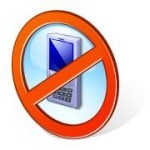
For the purposes of the FMCSA regulations at 49 CFR 392.80 & 392.82 the ban applies to the following engaged in interstate commerce:
- A gross vehicle weight rating or gross combination weight rating, or gross vehicle weight or gross combination weight, of 4,536 kg (10,001 pounds) or more, whichever is greater; or
- A vehicle designed or used to transport more than 8 passengers (including the driver) for compensation; or
- A vehicle designed or used to transport more than 15 passengers, including the driver, and is not used to transport passengers for compensation; or
- A shipment of hazardous materials that requires placarding pursuant to 49 CFR 172, Subpart F.
For the purposes of the PHMSA regulations at 49 CFR 177.804, which refer you to the FMCSA regulations, the ban applies to the following engaged in interstate and intrastate commerce:
- A shipment of hazardous materials that requires placarding pursuant to 49 CFR 172, Subpart F or any quantity of a material listed as a select agent or toxin by the Department of Health and Human Services at 42 CFR part 73.
Both agencies define prohibited activities as follows:
- Driver of the vehicle may not use a hand-held mobile phone or text while driving, nor may the employer allow such activity.
- “Driving” includes temporary stops for traffic jams, at a traffic light or sign, or if you are not pulled off the highway and halted in a safe manner.
- Prohibited texting includes but is not limited to: Short Message Service (SMS), Instant Messaging (IM), e-Mailing, accessing the internet, any other form of electronic text retrieval.
- Prohibited use of a hand-held mobile telephone includes:
- Holding a mobile telephone while communicating by voice.
- Dialing by pressing more than one button.
- Reaching for a mobile phone in an unsafe or unacceptable manner (see 49 CFR 393.93).
But you need to communicate, right? So what’s a driver to do? Here are some options to remain compliant and in-touch:
- Texting & use of hand-held telephone while driving is OK when necessary to communicate with law enforcement or emergency services.
- Texting & use of hand-held telephone is OK in a vehicle with or without the motor running when on the side of, or off, the highway and halted in a location where the vehicle can safely remain stationary.
- Use an acceptable hands-free telephone that the driver can access safely and operate solely by pushing one button.
In addition to the above Federal regulations, the use of mobile communication devices are regulated, and in many cases banned, by State laws and local ordinances.
If you transport any quantity of a hazardous material in commerce, no matter whether it is required to be placarded or not, you are a HazMat Employee and require triennial training pursuant to 49 CFR 172, Subpart H.
Contact me to schedule the required training for all of your HazMat Employes.
